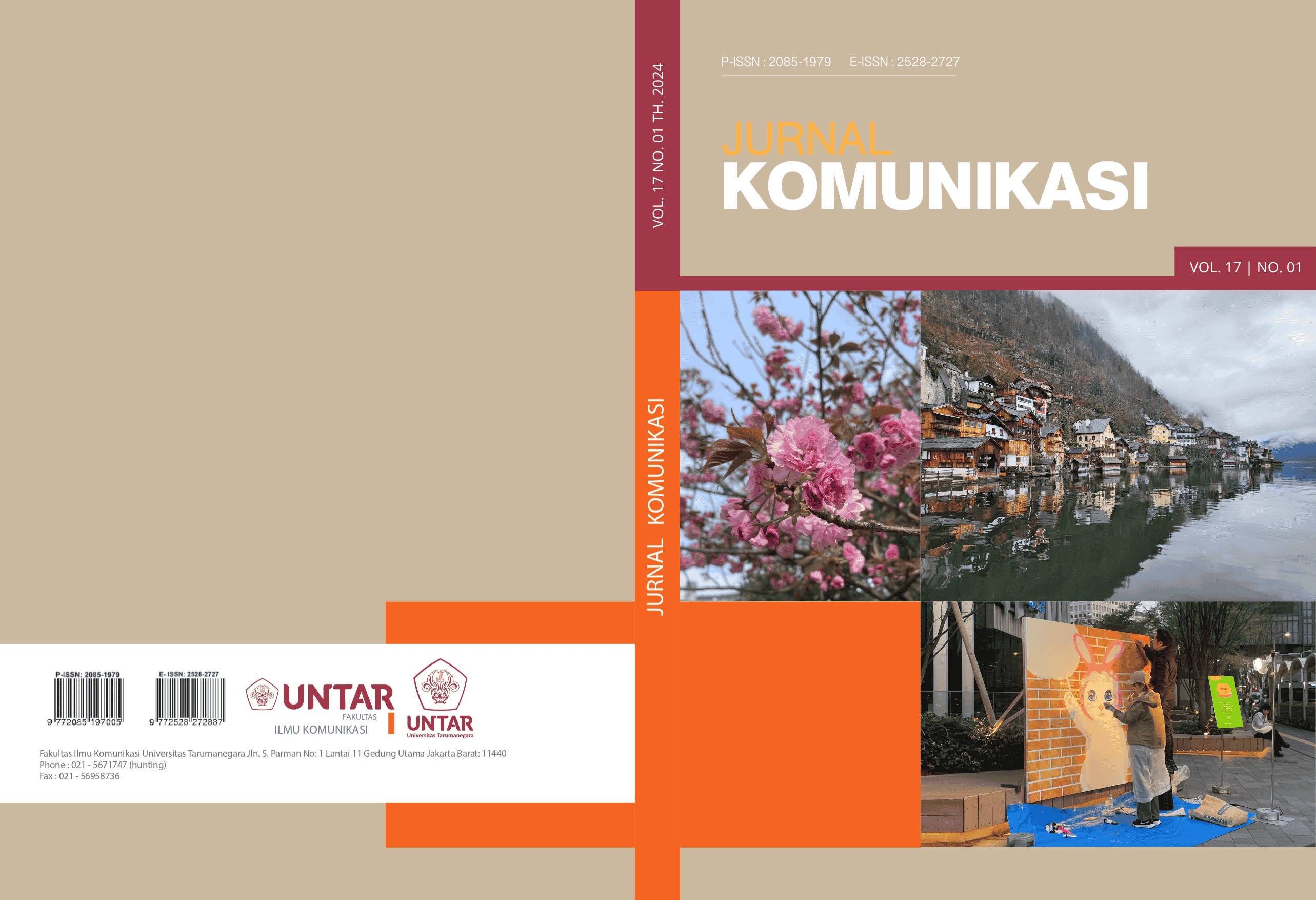Cultural Communication Study: The Symbolic Meaning of Worshipping the Abdi Dalem at the Ngayogyakarta Hadiningrat Palace
Main Article Content
Abstract
Ngayogyakarta Hadiningrat Palace is located in the Special Region of Yogyakarta. The Sultanate of Ngayogyakarta Hadiningrat is recognized as the nation's cultural heritage which has been passed down from generation to generation and is regulated in the Law on the Special Region of Yogyakarta No. 13 of 2012. The courtier at the Ngayogyakarta Hadiningrat Palace is one of the actors of Javanese cultural preservation. They are people who dedicate their lives to working in the palace and come from people who have blood relations with the royal family or ordinary people who have a desire to devote themselves. The Abdi Dalem of the Ngayogyakarta Palace consists of two groups, namely Keprajan and Punakawan. A courtier is a person who has retired and gives time, knowledge, and energy to help the palace, while the courtier is punakawan from the general public. Punakawan courtiers are still divided into two groups, namely Punakawan Tepas who have working hours like office employees, and Punakawan Caos who is on duty every ten days. The majority of palace courtiers come from the Javanese ethnic group, the largest ethnic group in Indonesia. For the courtier, if he is in the environment, the philosophy of the court is applicable which means that every movement of the courtier is obliged to perform sembah in the palace. Every time he steps past a certain place or object, the courtier is required to perform sembah, cupping both palms in front of his chest with his head slightly lowered. This qualitative research with an ethnographic approach was carried out at the Ngayogyakarta Hadiningrat Palace by interviewing three resource persons from different districts or tepas. Sembah is one of the symbols of respect or greetings taklim to people of higher rank or places in the palace that are considered sacred. Sembah does not mean worship as in the concept of worship of Balinese Hindus. When performing sembah, the thumb of the hand faces upwards as symbol of the relationship with God while the other four fingers are straight forward as symbol of the relationship with nature, the relationship with man, the relationship with animals, and finally the relationship with the invisible nature. Male sembah is different from female sembah.
Article Details

This work is licensed under a Creative Commons Attribution-ShareAlike 4.0 International License.
This work is licensed under a Jurnal Komunikasi Creative Commons Attribution-ShareAlike 4.0 International License.References
Achmad, S. W. (2018). Etika Jawa Pedoman Luhur dan Prinsip Hidup Orang Jawa (F. N. A, Ed.). Araska.
Aji, K. R. M. (2018). Ajaran Kejawen Maneges Agama Asli Jawa. Bening Pustaka & Rua Aksara.
Anshori, N. S., & Yuwono, I. (2013). Makna Kerja (Meaning of Work) Suatu Studi Etnografi Abdi Dalem Keraton Ngayogyakarta Hadiningrat Daerah Istimewa Yogyakarta. Jurnal Psikologi Dan Organisasi, 2(3), 157–162. http://journal.unair.ac.id/JPIO@makna-kerja-(meaning-of-work)-article-5616-media-50-category-10.html
Bungin, B. (2011). Penelitian Kualitatif: Komunikasi, Ekonomi, Kebijakan Publik, Dan Ilmu Sosial Lainnya. In Kencana. https://doi.org/10.1002/jcc.21776
Cikal Bakal Karaton Ngayogyakarta Hadiningrat. (n.d.). Website Kraton Jogja. Retrieved July 6, 2020, from https://www.kratonjogja.id/cikal-bakal/detail
Creswell, J. W. (2019). Penelitian Kualitatif & Desain Riset (3rd ed.). Pustaka Pelajar.
Dasrun, H., Kuswarno, E., Zubair, F., & Hafiar, H. (2017). Negosiasi Citra Budaya Masyarakat Multikultural. Jurnal ASPIKOM, 3(2), 157–172. http://jurnalaspikom.org/index.php/aspikom/article/view/125/119
Endraswara, S. (2018). Agama Jawa: Ajaran, Amalan, dan Asal-usul Kejawen (Edisi Baru). Narasi.
Hidayani, O. M., & Macaryus, S. (2019). Pemakaian Bahasa Jawa di Lingkungan Kraton Yogyakarta: Kajian Sosiolinguistik. Caraka, 6(1), 42. https://doi.org/10.30738/.v6i1.6589
Muchtar, K., Koswara, I., & Setiaman, A. (2016). Komunikasi Antar Budaya Dalam Perspektif Antropologi. Jurnal Manajemen Komunikasi, 1(1), 113–124. https://doi.org/10.24198/jmk.v1i1.10064
Ningsih, W. L. (2021, July 3). Keraton Yogyakarta: Sejarah Berdirinya, Fungsi, dan Kompleks Bangunan. Kompas.Com. https://www.kompas.com/stori/read/2021/07/03/180000279/keraton-yogyakarta-sejarah-berdirinya-fungsi-dan-kompleks-bangunan?page=all
Nugroho, A. C. (2021). Teori Utama Sosiologi Komunikasi (Fungsionalisme Struktural, Teori Konflik, Interaksi Simbolik). Majalah Semi Ilmiah Populer Komunikasi Massa, 2(2), 185–194. //jurnal.kominfo.go.id/index.php/mkm/article/view/4525
Rakhmat, J., & Ibrahim, I. S. (2017). Metode Penelitian Komunikasi (R. K. Soenandar, Ed.; Revisi 2). Simbiosa Rekatama Media.
Retnaningtyas, H. R. E., Nababan, M. R., & Purnanto, D. (2019). Bagongan Language Representation in Abdi Dalem Keraton Ngayogyakarta Hadiningrat Daily Life. Proceedings of the Third International Conference of Arts, Language and Culture (ICALC 2018), 272–277. https://doi.org/10.2991/icalc-18.2019.39
Sudaryanto, A. (2018). Hak dan Kewajiban Abdi Dalem Dalam Pemerintahan Kraton Yogyakarta. Mimbar Hukum, 20(1), 163–177. https://journal.ugm.ac.id/jmh/article/view/16321/10867
Susila, P. G., & Abidin, Z. (2016). Pengalaman Menjadi Abdidalem Punokawan Keraton Ngayogyakarta Hadiningrat: Studi Kualitatif Dengan Interpretative Phenomenological Analysis. Empati, 5(1), 106–112. https://ejournal3.undip.ac.id/index.php/empati/article/view/15062/0
Tugas dan Fungsi Abdi Dalem. (2016). Karaton Ngayogyakarta Hadiningrat. https://www.kratonjogja.id/abdi-dalem/3/tugas-dan-fungsi-abdi-dalem
Yuliati, R. (2022). The Terms of Types, Principles, and Hierarchy of Abdi Dalem of Ngayogyakarta Hadiningrat Palace as the Identity of the Speaker. Deskripsi Bahasa, 5(2), 73–84. https://doi.org/10.22146/DB.V5I2.5827
Yuwanto, L. (2013). Abdi Dalem Keraton Yogyakarta : Kesetiaan Dan Agen Pelestari Budaya. Universitas Surabaya (UBAYA). https://www.ubaya.ac.id/2018/content/articles_detail/88/Abdi-Dalem-Keraton-Yogyakarta---Kesetiaan-dan-Agen-Pelestari-Budaya.html



